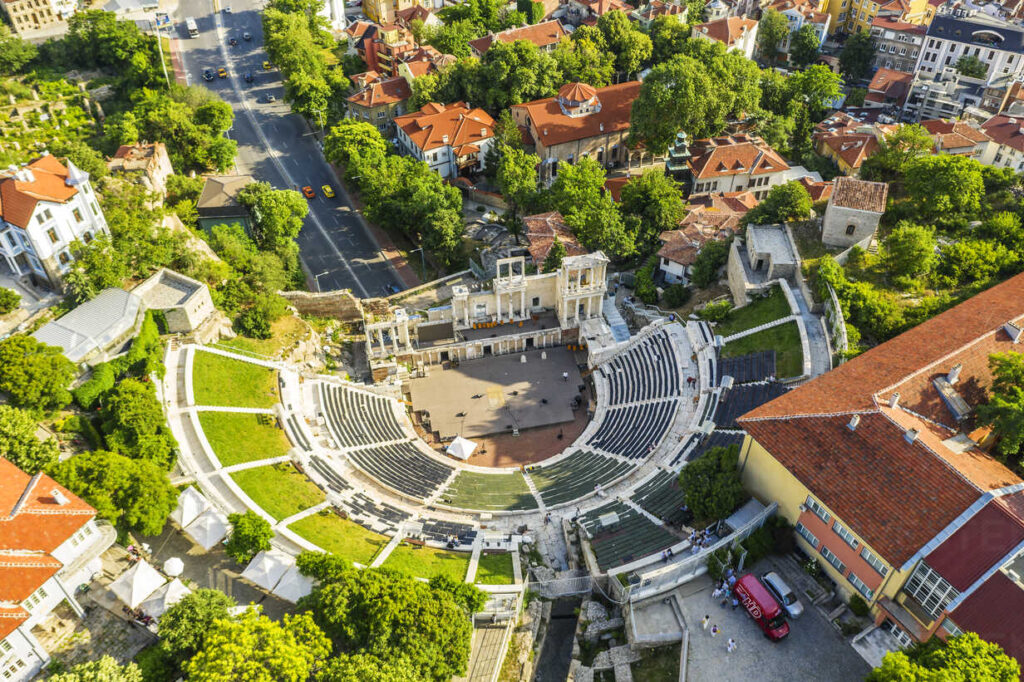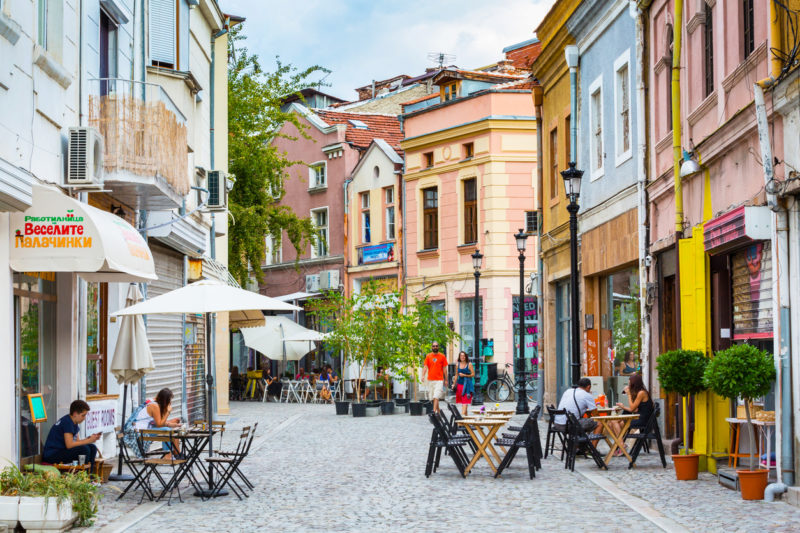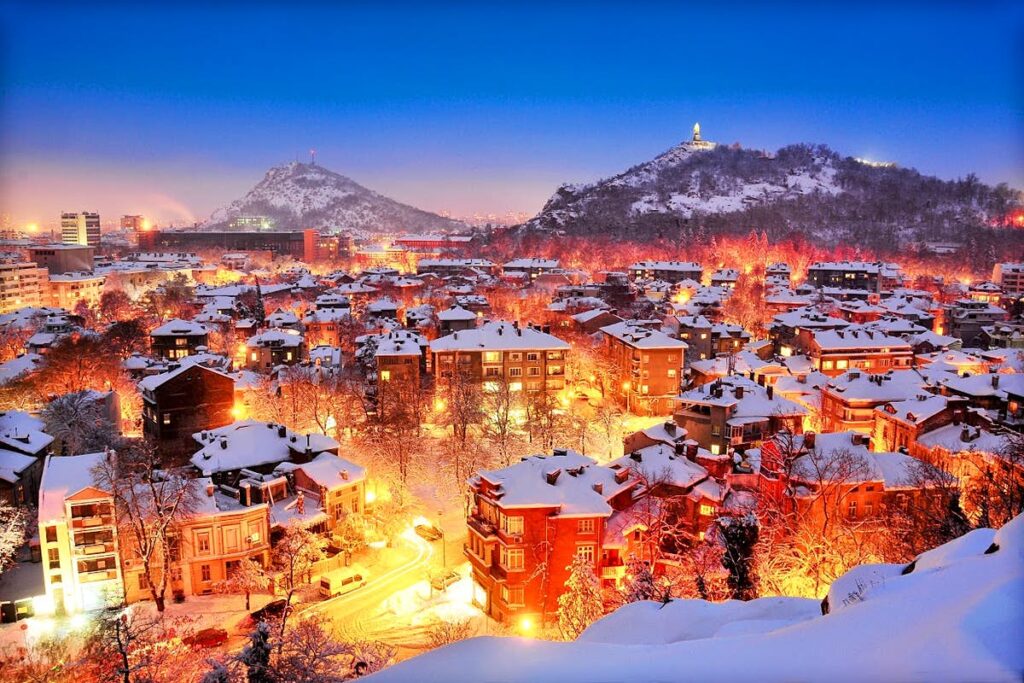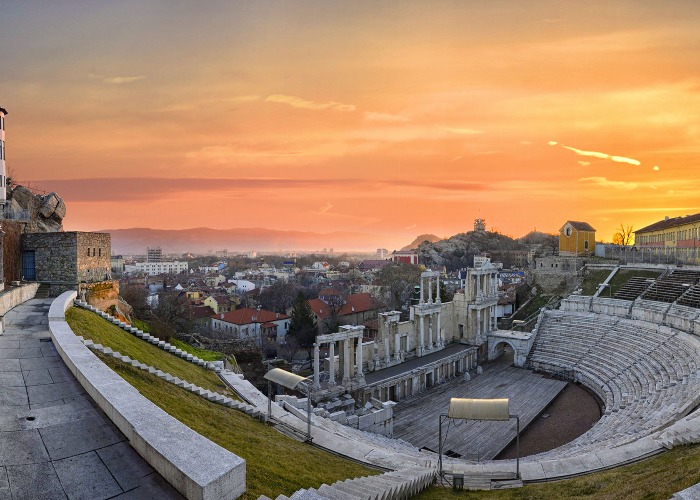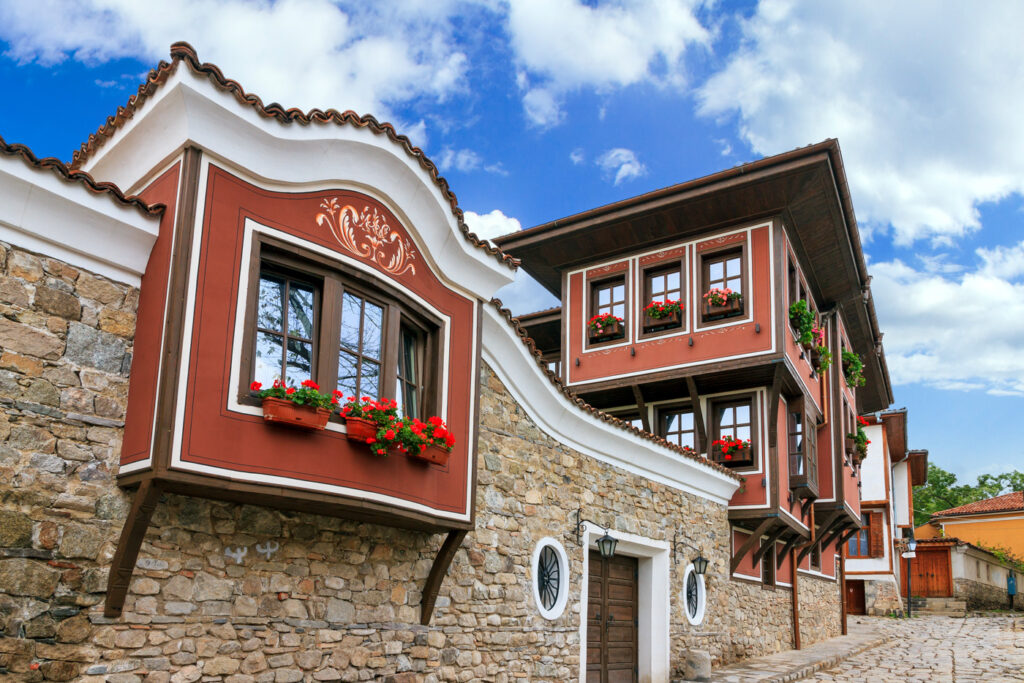Plovdiv is the second-largest city in Bulgaria, standing on the banks of the Maritsa river in the historical region of Thrace. Plovdiv is the cultural capital of Bulgaria and was the European Capital of Culture in 2019. It is an important economic, transport, cultural, and educational center.
Plovdiv is situated in a fertile region of south-central Bulgaria on the two banks of the Maritsa River. The city has historically developed on seven syenite hills, some of which are 250 metres (820 feet) high.
Because of these hills, Plovdiv is often referred to in Bulgaria as “The City of the Seven Hills”.
There is evidence of habitation in Plovdiv dating back to the 6th millennium BCE, when the first Neolithic settlements were established. The city was subsequently a Thracian settlement and later ruled by Persians, Greeks, Celts, Romans, Goths, Huns, Bulgars, Slavs, the Rus’, Crusaders, and Turks.
Main sights
The city has more than 200 archaeological sites, 30 of which are of national importance. There are many remains from antiquity. Plovdiv is among the few cities with two ancient theatres; remains of the medieval walls and towers; Ottoman baths and mosques; a well-preserved old quarter from the National Revival period with beautiful houses; churches; and narrow paved streets. There are numerous museums, art, galleries and cultural institutions. Plovdiv is host to musical, theatrical, and film events. The Knyaz Alexander I Street is the main street in Plovdiv.
The city is a starting point for trips to places in the region, such as the Bachkovo Monastery at 30 km (19 mi) to the south, the ski-resort Pamporovo at 90 km (56 mi) to the south or the spa resorts to the north Hisarya, Banya, Krasnovo, and Strelcha.
Roman City
The Ancient theatre (Antichen teatur) is probably the best-known monument from antiquity in Bulgaria. During recent archaeological survey, an inscription was found on a postament of a statue at the theatre. It revealed that the site was constructed at the 90s of the 1st century CE. The inscription itself refers to Titus Flavius Cotis, the ruler of the ancient city during the reign of Emperor Domitian.
The Ancient theatre is situated in the natural saddle between two of the Three Hills. It is divided into two parts with 14 rows each divided with a horizontal lane. The theatre could accommodate up to 7,000 people.
The three-story scene is on the southern part and is decorated with friezes, cornices, and statues. The theatre was studied, conserved, and restored between 1968 and 1984. Many events are still held on the scene including the Opera Festival Opera Open, the Rock Festival Sounds of the Ages, and the International Folklore festival. The Roman Odeon was restored in 2004. It was built in the 2nd–5th centuries and is the second (and smaller) antique theatre of Philipopolis with 350 seats. It was initially built as a bulevterion, an edifice of the city council, and was later reconstructed as a theatre.
Museums and protected sites
The Archaeological Museum was established in 1882 as the People’s Museum of Eastern Rumelia. In 1928 the museum was moved to a 19th-century edifice on Saedinenie Square built by Plovdiv architect Josef Schnitter. The museum contains a rich collection of Thracian art. The three sections “Prehistory”, “Antiquity”, and “Middle Ages” contain precious artifacts from the Paleolithic to the early Ottoman period (15th–16th centuries). The famous Panagyurishte treasure is part of the museum’s collection.
The Plovdiv Regional Historical Museum was founded in 1951 as a scientific and cultural institute for collecting, saving, and researching historical evidence about Plovdiv and the surrounding region from 16th to 20th centuries. The exhibition is situated in three buildings.
The Plovdiv Regional Ethnographic Museum was inaugurated in 1917. On 14 October 1943, it was moved to a house in the Old Town. In 1949 the Municipal House-museum was reorganized as a People’s Ethnographic Museum and in 1962 it was renovated. There are more than 40,000 objects.
The Museum of Natural Science was inaugurated in 1955 in the old edifice of the Plovdiv Municipality built in 1880. It is among the most important museums in the country with rich collections in its Paleontology, Mineralogy, and Botanic sections. There are several rooms for wildlife and it contains Bulgaria’s largest freshwater aquarium with 40 fish species. It has a collection of minerals from the Rhodope mountains.
The Museum of Aviation was established on 21 September 1991 on the territory of the Krumovo airbase 12 km (7 mi) to the southeast of the city. The museum possesses 59 aircraft and indoor and outdoor exhibitions.
The Old Town of Plovdiv is a historic preservation site known for its Bulgarian Renaissance architectural style. The Old Town covers the area of the three central hills (Трихълмие, Trihalmie). Almost every house in the Old Town has its characteristic exterior and interior decoration.
Churches, mosques and temples
There are a number of 19th-century churches, most of which follow the distinctive Eastern Orthodox construction style. They are the Saint Constantine and Saint Helena, the Saint Marina, the Saint Nedelya, the Saint Petka, and the Holy Mother of God Churches. As the city has been a gathering center for Orthodox Christians for a long period of time, Plovdiv is surrounded by several monasteries located at the foot of the Rhodope Mountains such as “St. George”, “St. Kozma and Damian”, St. Kirik, and Yulita (Ulita). They remain good examples of the late Middle Age Orthodox architecture and iconography masterpieces typical for the region. There are also Roman Catholic cathedrals in Plovdiv, the Cathedral of St Louis being the largest. There are several more modern Baptist, Methodist, Presbyterian, and other Protestant churches, as well as older style Apostolic churches. Two mosques remain in Plovdiv from the time of Ottoman rule. The Djumaya Mosque is considered the oldest European mosque outside Moorish Spain.
The Sephardic Plovdiv Synagogue is at Tsar Kaloyan Street 13 in the remnants of a small courtyard in what was once a large Jewish quarter. Dating to the 19th century, it is one of the best-preserved examples of the so-called “Ottoman-style” synagogues in the Balkans. According to author Ruth E. Gruber, the interior of the Plovdiv Synagogue is a “hidden treasure…a glorious, if run-down, burst of color.” An exquisite Venetian glass chandelier hangs from the center of the ceiling, which has a richly painted dome. All surfaces are covered in elaborate, Moorish-style, geometric designs in once-bright greens and blues. Torah scrolls are kept in the gilded Aron-ha-Kodesh.
Culture
Theatre and music
The Plovdiv Drama Theatre is a successor of the first professional theatre group in Bulgaria founded in 1881. The Plovdiv Puppet Theatre, founded in 1948, remains one of the leading institutions in this genre. The Plovdiv Opera was established in 1953.
Another pillar of Plovdiv’s culture is the Philharmonic, founded in 1945. Soloists such as Dmitri Shostakovich, Sviatoslav Richter, Mstislav Rostropovich, Yuri Boukov, and Mincho Minchev have worked with the Plovdiv Philharmonic. The orchestra has toured in almost all of the European countries.
The Trakiya Folklore Ensemble, founded in 1974, has performed thousands of concerts in Bulgaria and more than 42 countries. The Trakiya Traditional Choir was nominated for a Grammy Award. The Detska Kitka Choir is one of the oldest and best-known youth choirs in Bulgaria and the winner of numerous awards from international choral competitions. The Evmolpeya choir is another girls’ choir from Plovdiv, whose establishing patron, Ivan Chomakov, became the then mayor in 2006. The choir was appointed a Goodwill Ambassador and a municipal choir.
Literature
Plovdiv is among the nation’s primary literary centres. In 1855 Hristo G. Danov created the first Bulgarian publishing company and printing-press. The city’s traditions as a literary centre are preserved by the first public library in Bulgaria, the Ivan Vazov National Library, the 19 chitalishta (cultural centres), and by numerous booksellers and publishers. The library was founded in 1879 and named after the famous Bulgarian writer and poet Ivan Vazov who worked in Plovdiv for five years creating some of his best works. Today the Ivan Vazov National Library is the second largest national library institution with more than 1.5 million books, owning rare Bulgarian and European publications.
Arts
The city has traditions in iconography since the Middle Ages. During the Period of National Revival, a number of notable icon-painters (called in Bulgarian zografi, зографи) from all regions of the country worked in Plovdiv such as – Dimitar Zograf, his son Zafir Zograf, Zahari Zograf, Georgi Danchov, and others. After the Liberation, the Bulgarian painter of Czech origin Ivan Mrkvička came to work in the city. The Painters’ Society was established there by artists from southern Bulgaria in 1912 whose members included painters Zlatyu Boyadzhiev, Tsanko Lavrenov and Sirak Skitnik.
Today the city has more than 40 art galleries with most of them being privately owned. The Art Gallery of Plovdiv was founded in the late 19th century. It possesses 5,000 pieces of art in four buildings. Since 1981, it has had a section for Mexican art donated by Mexican painters in honour of the 1,300-year anniversary of the Bulgarian State.
European Capital of Culture
After Plovdiv was elected as European Capital of Culture in 2019, an ambitious cultural program has started its realisation. According to this program, there will be an Island of Arts in the middle of the Maritsa River in Plovdiv. The “Kapana” area (the “Trap”) will become a quarter of the arts where the creative industries are going to be developed and presented. This famous area, Kapana, was renovated in 2014, restoring its authentic outlook. It has been used for a number of festivals and art events, attracting visitors from all over Bulgaria and the world.
For 2019 the City Under the Hills is planning a number of concerts, including “Balkan Music in Plovdiv”.The city will host the Plovdiv Biennale and a number of international forums, such as a meeting of collectors from Europe, a summer art school, dance projects, etc.

